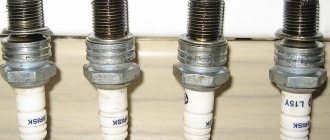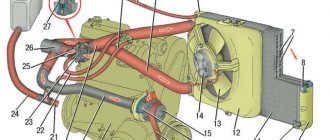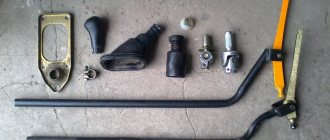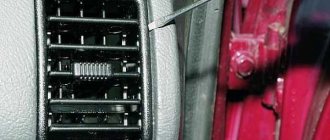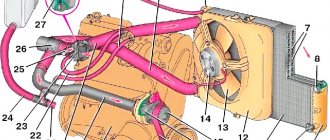Solving the problem of airing the engine cooling system on Lada cars
Have you noticed that the heater in your car is blowing cold air?
There may be several reasons for the problem, but most often this occurs due to the formation of an air lock in the engine cooling system. Next, we will tell you how to remove air from the cooling system of Lada cars (Granta, Kalina, Priora, Largus, Niva, Vesta or XRAY) in several ways. Let us remind you that AvtoVAZ installs the same type of power units on its models, so the instructions are similar for all Lada cars.
How to flush the cooling system of a VAZ 2110
During operation, a variety of deposits occur in the engine cooling system. This is due to the use of coolant of poor quality. Also, sediment on the engine walls occurs when the car is operated on water. This is what many car drivers do. In order not to waste money on antifreeze, in the warm season they use an aqueous solution. For this reason, not only do the channels become dirty, but the fluid circulation throughout the entire cooling system is disrupted. The result is engine overheating, a non-working stove and much more.
To properly clean the cooling system, you need to drain the liquid and then pour in distilled water with a special additive.
After this procedure, you need to turn on the engine for a few minutes, and then drain the aqueous solution along with all waste.
Below we will learn how to properly and efficiently flush the cooling system so that there are no difficulties later.
Method No. 1
- Remove the hose from the throttle body heating.
- Open the cap of the expansion tank, cover the neck with a clean rag and blow into the tank.
- When antifreeze starts flowing from the removed tube, quickly put the hose back in place and tighten it with a clamp.
Attention! Coolant is a toxic substance, so we recommend that you use other methods to solve the problem.
Method No. 2
- Warm up the engine until pressure builds up in the engine cooling system.
- Stop the engine and remove the hose from the throttle body heating. We do not open the expansion tank cap.
- As soon as antifreeze runs out of the hose, quickly put it back on and tighten it with a clamp.
Attention! Antifreeze can be very hot, be careful.
How to “drive out” a traffic jam?
There are several ways to eliminate a blockage in the cooling circuit of the Lada Kalina power plant. Next, let's look at their features and how to remove air.
Method one
The location of the throttle assembly appears as a design convenience for the LADA Kalina cooling circuit. It is located at the highest point of the system. The procedure for eliminating a traffic jam is as follows.
- We set the heater temperature switch (knob in the cabin) to maximum.
- Under the hood, remove the valve cover protective panel.
- Use a screwdriver (cross-shaped) to loosen the clamp and remove the rubber inlet pipe from the throttle body fitting (you can also resort to removing the outlet hose).
- Unscrew the cap on the expansion tank.
- Now we use our own mouth. With its help and through a sterile cloth, we pump the air accumulated in the lungs into the expansion tank. We do this until antifreeze appears from the specified fitting.
- If this is successful, then return the hose to its place, secure it and screw the cap onto the tank.
However, this is not the only method of removing air.
Method two
Its principle closely echoes the manipulations in the first method. There is no need to get your mouth dirty or even open the tank lid. All actions boil down to:
- warm up the engine to operating temperature and turn it off;
- carefully removes the same hose from the throttle assembly;
- We observe liquid flowing out of the fitting: if it appears, then return the hose and tighten the clamp;
- a one-time manipulation may not be successful, so we repeat the procedure again until the liquid appears.
Method three
Let's look at another option for pumping air. Let us immediately note that this method is not particularly effective. The actions do not involve disassembling the system.
- Here you will need to drive your front wheels onto an embankment so that the highest point of the contour is the air plug in the cooling system on the radiator housing.
- It must be removed, as well as the cap on the expansion tank.
- We start the engine and bring the temperature in the circuit to the operating parameter.
- We observe a decrease in the volume of antifreeze in the LADA Kalina tank and immediately replenish it to the required level. During the process, air bubbles will be released from the liquid.
- We carry out the action until the release of air stops, as evidenced by the absence of “foaming” of the liquid inside the tank.
- We return the previously removed plug and cover to their original places.
Method No. 3
- With the engine cooled down, remove the upper hose from the expansion tank coming from the radiator of the cooling system.
- Fill the reservoir to the maximum with coolant and tighten the cap.
- We place the hose in an empty canister, and put a hose from the air pump (for inflating tires) on the tank nozzle.
- We pump up the pressure in the tank with a pump, and at the same time the antifreeze will pour into the canister.
- We monitor the level of coolant in the expansion tank and add it if necessary.
- After 2-3 additions of liquid, we restore all connections.
If air in the cooling system occurs periodically, then the car’s cooling system is not sealed. Check the connections of all system hoses for leaks, as well as the expansion tank cap. See also other photo reports on DIY Lada repairs.
Removing an air lock in the cooling system on a Priora
Welcome! An air lock - it can be created anywhere, namely in the engine cooling system, also sometimes air gets into the braking system and the car starts to brake very, very poorly (If there is a lot of air, the car will not brake at all), but also with with the cooling system, everything is not so clear; when air gets into it, the car’s engine, the first thing that starts to heat up too much and eventually overheats, in addition to this, the heater will still work poorly (the air from it will come out cold, when the car’s engine is warmed up ) and therefore air must be expelled from any system; in the brake system this is done using fittings and a hose with a bottle, but with the cooling system everything is simpler and no bottle or hose will be needed to expel the plug from the system.
Note! To remove the air lock from the system, you just need to find: A slight slope, and you may also need a screwdriver, so stock up on that!
Summary:
When should you remove an air lock in the cooling system? If you have recently begun to notice that the car has begun to heat up very much, and you have recently replaced the coolant with a new one and before that, the car did not heat up so much even with the old coolant, this indicates that air has entered the system and the fluid was replaced incorrectly, in addition, in order to be 100% sure that the system is aired, turn on the heater when the car’s engine is fully warmed up (the heater should be working in this case) and see what kind of air comes out of it, if slightly warmed up then in this case In this case, your heater fan is broken and needs to be replaced, but if cold air comes out when the engine is warm, then this indicates that there is a plug in your cooling system.
Introduction
Due to the cooling system, the vehicle is able to very quickly reduce the temperature of the main engine parts heated during operation and other components that are subject to overheating. It is worth noting that not only the parts are cooled, but also the gas and oil. Using a simple device, the engine is protected from severe overheating. With the help of various coolants, which are antifreeze and antifreeze, “traveling” through special channels, heat is taken and subsequently cooled in the system radiator. However, the functionality of the unit may be impaired, which is most often caused by the appearance of an air lock. In the material below, we will consider three effective methods that have proven their effectiveness in practice and can help any motorist whose VAZ-2115 stove has become airy.
How to remove a plug in the cooling system on a VAZ 2170-VAZ 2172?
1. There are only a few ways, each of which we will consider today, firstly, the very first method is very simple and does not require a lot of effort, you will need to find at the beginning any climb or slide and after finding it, drive up it and putting the car in neutral gear (the front should be higher than the rear), after standing for two minutes, let it idle and turn on the heater, make sure that the plug is removed from the system, otherwise let the car sit the same time, but apply gas at the same time, this way the traffic jam will most likely be removed.
2. The second is also an effective method and it consists of the following: you need to unscrew the cap of the expansion tank (Indicated by the arrow in the photo below) when the car is not warmed up (it will still be cold, to put it simply), then get into the car and start its engine , let the car run for three, four or even five minutes (If necessary), then turn it off and turn on the heater, thereby making sure whether the air lock has left the system or not.
How to remove an air lock from a car's cooling system: instructions
Hi all! From time to time, in many cars it happens that an air lock forms in the cooling system. It would seem that there is nothing wrong. But in fact, this phenomenon can lead to quite serious negative consequences. That is why I propose to talk about how to remove an air lock from the cooling system.
This problem falls into the category of those that can be fixed with your own hands. You just need to figure out how to remove the air correctly so as not to cause additional harm to other systems of your car.
Before we begin describing the procedures, of which we will have three, I will tell you about the signs of airiness, causes and possible consequences.
If you are ready, then we begin.
Symptoms
Symptoms or signs of airiness are not difficult to recognize. To do this, you just need to pay attention to the uncharacteristic behavior of your vehicle.
Although sometimes it happens that the driver, calmly operating his car, does not even suspect that a harmful air plug has long ago formed inside the cooling system. Signs of such a malfunction are as follows:
- The thermostat breaks. When the fan turns on almost immediately after starting the engine, there is probably a problem in the system. Air sometimes accumulates in the pipes, which provokes circulation only along the internal circuit of the cooling jacket;
- The coolant temperature indicator arrow is in the zero position, even when the engine is warmed up;
- There is a coolant leak. Look under the car to see if there are traces of coolant. This will also help determine where exactly the leak is;
- The engine overheats with enviable regularity. This symptom indicates impaired circulation;
- When the pump operates, extraneous noise occurs;
- The stove is not working properly. It’s not a fact that the reason is precisely airing. But it's worth checking.
If you observe one or more of the symptoms presented, you should check the operation of the cooling system. If you have a new and good foreign car, I don’t recommend going there with your own hands. But everyone decides for themselves.
Plus, keep an eye on the dashboard icons for signals. They will tell you if the engine is overheating, and more.
Causes
Since everything is clear with the signs, you can move on to the reasons why your injector may experience airing in the cooling system.
There is no point in fixing the problem until its causes have been identified. Otherwise, you can disassemble half the machine without achieving the desired result. And it doesn’t matter whether you have a Gazelle, a new Solaris or some Mercedes S-Class.
Airing often occurs due to:
- depressurization;
- incorrect addition of coolant;
- malfunction of the air valve;
- formation of suction due to the pump;
- cooling fluid leaks;
- mechanical damage to system elements;
- normal wear and tear;
- failure of the cylinder head gasket;
- incorrectly performed previous repairs.
Having dealt with the source of the trouble, you first need to get rid of the cause of the airiness. And only then you should proceed directly to the procedure for removing the airlock.
If you were unable to figure out the reasons on your own, it is better not to continue to study the ins and outs of your vehicle on your own. Contact a good car service center, where specialists, using professional and precise equipment, will carry out all the necessary diagnostic measures.
Consequences
If an air lock is detected in the automotive cooling system of an 8-cl engine or any other engine, there is no point in postponing repairs until later.
Since the circulation of cooling fluid in the car is disrupted, very soon the engine itself and all associated equipment will begin to suffer. The engine will not cool properly, and operating the car at elevated temperatures leads to extremely rapid wear of the elements.
Removal methods
Now let’s move on directly to how to remove the formed air plug from the cooling system without resorting to the help of specialists.
I can offer 3 methods in total. Each of them has its own characteristics and can be used for certain cars. Therefore, think carefully before settling on one of the methods.
First method
This option is suitable for owners of VAZ cars, including:
- VAZ 2107;
- 2110;
- VAZ 2114;
- 2109;
- VAZ 2115;
- Lada Kalina;
- Priora;
- Lada Granta;
- VAZ 2111;
- VAZ 2108, etc.
If you have just such machines, then you can safely get to work.
The procedure looks like this:
- Access to the tank where the coolant is located opens. It is necessary to remove the security elements;
- Now one of the 2 pipes that go to heating the throttle is turned off. It doesn’t matter which pipe to disconnect;
- Remove the lid from the tank and cover the hole with a low-density rag;
- Blow into the reservoir to create excess pressure. You should blow until air comes out of the nozzle;
- Coolant should leak out soon. At this moment you need to secure the pipe with a clamp. Here it is worth turning to a friend for help;
- If the pipe is not secured, a new plug may appear;
- Return all elements to their place;
- Start the engine and you can drive for a couple of kilometers.
In theory, the symptoms of malfunctions should disappear. Just keep in mind that the method is suitable specifically for domestic cars, since it is possible to disconnect the pipe on them.
Second method
If the first option for removing air pollution does not suit you, I suggest using the second method.
Here the procedure is carried out like this:
- Start the engine at idle;
- Let it run for 10-15 minutes;
- Turn off the engine;
- As in the previous instructions, remove the protective elements;
- Open access to the tank;
- Remove only 1 pipe;
- The coolant will circulate throughout the system;
- The air will begin to escape without your participation;
- When the antifreeze starts to come out, the pipe returns to its place.
The method is frankly not bad. But there is one drawback. It consists in the high temperature of the pipes. It is strongly not recommended to handle them with bare hands.
Turn on the heater and check whether the proper volume of hot air begins to flow into the cabin. If yes, everything went well, and therefore you can enjoy the result of your own repair. The job is no more difficult than bleeding the clutch.
Third method
It is considered the most difficult because you will need a jack or some kind of inclined surface to work.
You need to act in the following sequence.
- The car is placed on a jack to raise the front end higher than the rear of the car;
- It is important that the radiator cap is higher than other system components;
- Be sure to turn on the handbrake;
- Start the engine and let it idle;
- After 15 minutes, start working if the temperature has approached the operating parameters for the internal combustion engine;
- The covers are removed from the radiator cap and coolant reservoir;
- Smoothly press the gas pedal, gradually increasing the speed;
- At the same time, the assistant must add coolant to the reservoir;
- If bubbles are visible, the cork is coming out;
- Start the heater and continue pouring coolant;
- When you feel hot air in the cabin and the bubbles run out, the plug is out.
You can’t handle this yourself, so you’ll have to call an assistant. You should also carefully add coolant so as not to provoke the formation of a new plug. Always top up the coolant that is currently in the expansion tank. I have already told you separately about mixing antifreeze.
These three methods are used by the majority of car owners who decide to solve the problem of airing the cooling system with their own hands. If you have alternative options, be sure to write in the comments.
Thank you all for your attention! Subscribe, be sure to ask questions and invite your friends to join us!
(
3 ratings, average: 3.67 out of 5)
The stove does not heat well and blows cold air Lada Granta: reasons
The Lada Granta passenger car, which is considered one of the most affordable in the world, is equipped with a “stove” (or simply a heater) that is standard for VAZ cars. Typically this unit works very well, but problems can still occur. Therefore, if the Lada Granta stove does not heat well, then there must be reasons for this that simply need to be discovered.
We carry out diagnostics
If it is cold outside and the interior cannot warm up properly, then you need to check the operation of the cooling system, which has a direct effect on heating the interior.
Coolant level
To do this, you need to open the hood and, with the engine not warmed up, check where the coolant is located.
If its level in the tank is between the minimum and maximum marks, then everything is in order. But, when this level decreases, problems with the tightness of the cooling system are possible, and this leads to a decrease in pressure inside the system. If the problem is not corrected, the stove will not be able to warm the air in the cabin effectively enough.
Thermostat
This is a native Luzar thermostat
We are talking about the possible sticking of the thermostat valves in a position where the coolant circulates only in a larger circle. So, during the cold period, the coolant will not warm up to normal temperature, and therefore the interior will not become warmer.
Thermostat location under the hood
You can verify the presence of this particular breakdown by the fact that the car, while stuck in traffic jams, begins to overheat very quickly. In addition, when moving along the highway at a stable speed, the engine loses its temperature too quickly, if we talk about the cold season. However, even if these “symptoms” are not observed in your car, this does not mean that the thermostat is working properly. It is quite possible that its defect lies only in tangible problems with the interior heater.
For even more complex cases, you can check the pipes that connect to the heater radiator. Normally, one should be hot and the other just slightly warm. If the second of the pipes is very cold, this will indicate that the stove radiator in your car is clogged. It won't be easy to clean it. Most likely, you will have to completely remove the entire stove.
And for the most extreme situations, when none of the above helps, and there is very severe frost outside, you can simply block the radiator’s air supply with any dense object, such as cardboard or plastic.
If the thermostat is faulty during the cold period, the coolant will not warm up to normal temperature, and therefore the interior will not become warmer.
Air temperature regulator damper
If the cooling system of the Lada Granta is working properly, then the reason for the poor operation of the stove may lie in the functioning of the air temperature regulator damper.
The fact is that the position of this damper directly determines which air flow will follow through the heater radiator, and which flow will enter the car interior without reaching the radiator itself.
Blown-out air temperature regulator (either the slider or the cable with the mechanism to which the regulator transmits tension may be faulty)
The malfunction may relate to the heater control panel or poor operation of the gearbox through which the damper moves. Depending on its position before the breakdown, cool air can enter the cabin in the cold season or hot air in the summer.
Heater fan and fuse
The fuse box is indicated by an arrow
Also check whether the heater fan turns on. If it remains motionless, then you need to check the condition of the 30A fuse. It can be recognized by its green color and F4 index (in the picture above). It is located in the additional concentration of power fuses. It is located under the hood, near the expansion tank of the cooling system.
If everything is fine with this fuse, then most likely the problem lies in the electric fan motor itself . You can get to it only through a special hole, which will become accessible after removing the glove compartment lid.
If the fan operates at maximum speed and the air does not flow well into the cabin, then the problem is a clogged cabin filter; it needs to be cleaned, or better yet, replaced.
Resistor block
If your problem with the stove is that the fan remains operational only at the fourth speed, while the first three do not turn on at all, then the reason for this lies in the failure of the resistor unit. It will not be possible to repair it, so you can only count on its complete replacement. This unit can be accessed in the same way as an electric fan motor.
Fan of the “large” cooling radiator
There are cases when the cooling fan is constantly running, thereby preventing the coolant temperature from reaching operating limits. In other words, the coolant that should heat the heater radiator is cold, and the radiator cannot give off heat.
The engine does not have time to warm up
This problem arises due to the fact that the first Grant models were not equipped with an engine temperature indicator, and the driver started driving with an engine that was not warmed up. This is especially noticeable when trips are short.
Additional Tips
However, it also happens that the problem with heating the interior consists only of some small mistakes. Therefore, before you start disturbing the service center workers, check whether all the dampers on the stove are set in the required position. It wouldn’t hurt to tug the hot air damper a little.
There is a possibility that it is simply stuck. And, with a significant push, it will be moved from its place.
Source: https://carfrance.ru/pochemu-v-lada-granta-pechka-ploxo-greet-i-duet-xolodnym-vozduxom/
How can you remove an air lock from the cooling system?
The presence of air in the cooling system is fraught with problems for both the engine and other components of the car. In particular, overheating may occur or the stove will heat poorly. Therefore, it is useful for any motorist to know how to remove an air lock from the cooling system. This procedure is quite trivial, so even a beginner and inexperienced car enthusiast can do it. Due to its importance, we will talk about three methods of removing air. But first, let's talk about how to understand that air jams are occurring and the reasons for their occurrence.
Symptoms of airiness
How can you tell if there is an air lock in the cooling system? When this phenomenon occurs, several typical symptoms occur. Among them:
- Problems with the thermostat . More specifically, if after starting the engine the cooling fan turns on very quickly, then there is a high probability that the thermostat has failed. Another reason for this may be that air has accumulated in the pump nozzle. If the thermostat valve is closed, the antifreeze circulates in a small circle. Another situation is possible when the coolant temperature needle is at “zero” when the engine has already warmed up enough. Here again, two options are possible - a malfunction of the thermostat, or the presence of an air lock in it.
- Antifreeze leak . It can be checked visually by traces of antifreeze on individual elements of the engine or chassis of the car.
- The pump starts to make noise . When it partially fails, extraneous noise appears.
- Problems with the stove . There are many reasons for this malfunction, but one of them is the formation of an air lock in the cooling system.
If you find at least one of the symptoms described above, then you need to diagnose the cooling system. However, before doing this, it will be useful to understand what caused the possible problems.
Signs of airing
Before understanding the signs of an air lock in the cooling system, it is important to understand the operating principle of the VAZ 2110, 2114 or 2115 engine. When the solution is still cold, it moves through special channels in the cylinders - the so-called cooling jacket. No liquid gets into the radiator itself. Circulation occurs due to the pump (water pump).
When the cooled liquid heats up to a certain point, the thermostat is activated. This, in turn, activates a circle through which fluid circulates through the radiator structure. In case of poor cooling, the fan is automatically switched on. Maintaining the temperature of the internal combustion engine and the functioning of the stove inside the cabin depend on how efficiently the system works.
On a note! Overheating of the internal combustion engine is possible not only when it is airy. There are other reasons that should not be ignored.
If the fluid circulation is weak, the system begins to operate in an abnormal mode. The likelihood of engine overheating increases. The main symptoms of an air lock:
- Engine overheating is the main symptom. Characterized by a sharp jump in temperature, indicators reach the red zone. But when checking the antifreeze level, deviations may not be detected.
- In cold weather, there is no flow of warm air into the cabin when the engine is well warmed up.
- The red light on the dashboard lights up.
An air lock does not allow fluid to pass normally through the channels, which is why breakdowns occur. Therefore, it is important to check that all hoses and pipes are undamaged. If there is even a slight crack in the rubber pipes, air will leak out. It is difficult to notice it during inspection, but when air is supplied under pressure, damage can be detected.
If the thermostat element and the fan are not damaged, but the stove still does not work, then all these are symptoms of an air lock. The engine overheats due to air pollution that needs to be removed.
Causes of air locks
Air in the cooling system can be caused by a number of malfunctions. Among them:
- Depressurization of the system . It can occur in a variety of places - on hoses, fittings, pipes, pipes, and so on. Depressurization can be caused by mechanical damage to its individual parts, their natural wear, or a decrease in pressure in the system. If, after you have removed the air lock, air appears in the system again, it means that it is depressurized. Therefore, it is necessary to do diagnostics and visual inspection in order to identify the damaged area.
You need to pour antifreeze in a thin stream.
Each of the reasons described above can damage the components and mechanisms of the car. First of all the engine suffers because its normal cooling is disrupted. It overheats, causing wear to become critical. And this can lead to deformation of its individual parts, failure of sealing elements, and in especially dangerous cases, even to jamming.
Airing also leads to poor stove performance. The reasons for this are similar. Antifreeze does not circulate well and does not tolerate sufficient heat.
Next, let's move directly to the methods by which you can remove the air lock from the cooling system. They differ in the method of execution, as well as complexity.
Why is an air lock dangerous?
An air lock is an accumulation of air inside the channels of the cooling system, which impairs the circulation of coolant. It acts as a gap in the flow that antifreeze cannot overcome. The consequences of an air lock are serious:
- uneven heat removal from the components and mechanisms of the power plant;
- motor overheating;
- incorrect display of information from engine sensors;
- thermostat damage;
- the interior heating system stops working.
Dangerous consequences include uneven heat dissipation and overheating. Due to the temperature difference in the nodes, uneven expansion of the metal occurs, which causes warping of the composite mechanisms. And overheating of the motor leads to a violation of the geometry of the block head.
Methods for removing air lock from the cooling system
How to remove an air lock from the cooling system of a VAZ classic
There are three main methods by which you can eliminate an air lock. Let's list them in order. The first method is great for VAZ cars . Its algorithm will be as follows:
- Remove from the engine all protective and other elements that may prevent you from reaching the expansion tank with coolant.
- Disconnect one of the pipes that are responsible for heating the throttle assembly (it doesn’t matter whether it’s direct or reverse).
- Remove the expansion tank cap and cover the neck with a loose cloth.
- Blow inside the tank. This will create a slight excess pressure, which will be enough for excess air to escape through the pipe.
- As soon as antifreeze comes out of the hole for the pipe, immediately put the pipe on it and preferably secure it with a clamp. Otherwise, air will get back into it.
- Close the expansion tank cap and reassemble all previously removed engine protection elements.
The second method is carried out in accordance with the following algorithm:
- Start the engine and let it run for 10.15 minutes, then turn it off.
- Remove the necessary elements in order to get to the expansion tank with coolant.
- Without removing the lid from it, disconnect one of the pipes on the tank. If the system has been aired, then air will begin to escape from it.
- As soon as the antifreeze flows out, immediately replace the pipe and secure it.
The third method of how to remove an air lock from the system must be done as follows:
- It is necessary to place the car on a hill so that its front part is higher. It is important that the radiator cap is higher than the rest of the cooling system. At the same time, put the car on the handbrake, or better yet, put chocks under the wheels .
- Let the engine run for 10.15 minutes.
- Unscrew the caps from the expansion tank and radiator.
- Periodically press the accelerator pedal and add coolant to the radiator. This will cause air to escape from the system. You will notice it by the bubbles. Continue the procedure until all the air is released. In this case, you can turn on the stove to maximum mode. As soon as the thermostat opens the valve completely and very hot air enters the cabin, it means that the air has been removed from the system. At the same time, you need to check for bubbles coming out of the coolant.
As for the last method, on machines with an automatically turned on cooling system fan, you don’t even have to over-gas, but calmly let the engine warm up and wait until the fan turns on. At the same time, the movement of the coolant will increase, and under the influence of circulation, air will leave the system. In this case, it is important to add coolant to the system in order to prevent airing again.
As you can see, the methods of how to get rid of an air lock in the engine cooling system are quite simple. They are all based on the fact that air is lighter than liquid. Therefore, it is necessary to create conditions under which the air lock will be forced out of the system under pressure. However, it is best not to bring the system to that state and take preventive measures in a timely manner. We will talk about them further.
Additional Tips
However, it also happens that the problem with heating the interior consists only of some small mistakes. Therefore, before you start disturbing the service center workers, check whether all the dampers on the stove are set in the required position. It wouldn’t hurt to tug the hot air damper a little.
There is a possibility that it is simply stuck. And, with a significant push, it will be moved from its place.
According to reviews of many car owners, the Lada Kalina car is recognized as one of the warmest cars of domestic production. It is very warm in the car in winter, the interior is evenly heated and the rear passengers in the car are comfortable, since the hot air from the stove is supplied to the feet of the rear passengers in full and is not “lost” in the air tunnels of the ventilation system as in cars 2109 and 2110.
If one day it became cool inside the Lada Kalina car, and instead of the usual hot air, cold air began to blow from the stove, then there was a problem in the car’s engine cooling system. Malfunction of the cooling system can cause the engine to overheat to critical temperatures and lead to serious engine damage. An air lock can cause many problems in the cooling system of a Lada Kalina car. Before removing the plug, it is first recommended to check the entire car engine cooling system (SOD), since the cause of ineffective operation of the SOD and a cold stove can be not only an air lock in the system, but also a breakdown or deformation of the pump impeller, kinks in the pipes, or incomplete opening of the thermostat . Only after checking the entire cooling system should you begin to remove the air lock.
Signs of an air lock in the engine cooling system
An air lock creates an obstacle in the cooling system, due to which antifreeze or antifreeze cannot circulate and evenly cool a running engine.
Reasons for the appearance of an air lock in the engine cooling system:
— Air may enter the system when replacing or adding coolant.
— In the engine cooling system, there is a leak in external air due to weak compression of plastic fittings, loose clamps, a leaking radiator, a leak in the pump and a faulty expansion tank cap valve. One of the signs of a plug in the ODS is the gurgling of coolant under the instrument panel when the engine warms up.
To remove the plug, you need to loosen the clamp and remove tube 3 or 22 from the heating of the throttle assembly
— The cylinder head gasket (cylinder head) was blown. As a result of the breakdown, a coolant leak is visible from under the cylinder head. Exhaust gases escape from under the cylinder head, you can see the bubbling of antifreeze, the formation of an emulsion in the expansion tank, and white steam in the car exhaust.
An air lock in the SOD can form in both the small and large circulation circles. The disadvantage of Kalina's SOD is the location of the expansion tank in a large circle. As a result, until the thermostat opens completely, it is difficult to remove the airlock. Therefore, in the cold season, “gasification” helps, as a result of which the car warms up faster, and when the engine reaches a temperature of 101-105 degrees. The thermostat opens a large circulation circle and the air exits into the expansion tank.
General recommendations for prevention
The first thing you need to pay attention to is the level of antifreeze in the cooling system . Always monitor it and top up if necessary. Moreover, if you have to add coolant very often, then this is the first call indicating that something is wrong with the system, and additional diagnostics are necessary to identify the cause of the malfunction. Also check for stains from antifreeze leaks. It is better to do this in the inspection hole.
Try to use the antifreeze recommended by your car manufacturer. Make purchases in trusted, licensed stores, minimizing the likelihood of purchasing a counterfeit. The fact is that low-quality coolant can gradually evaporate during repeated heating, and instead of it, an air plug forms in the system. Therefore, do not neglect the manufacturer's requirements.
Instead of a conclusion
Finally, I would like to note that if the described signs of airing in the system appear, it is necessary to carry out diagnostics and check it as quickly as possible. After all, an air lock significantly reduces the efficiency of the cooling system. Because of this, the engine operates under conditions of increased wear, which can lead to premature failure. Therefore, if you detect airing, try to get rid of the plug as quickly as possible. Fortunately, even a novice car enthusiast can do this, since the procedure is simple and does not require the use of additional tools or devices.
Sources:
https://xn--80aal0a.xn--80asehdb/do-my-self/repair/repair-lada-vesta/175-reshenie-problemy-zavozdushivaniya-sistemy-ohlazhdeniya-lada-kalina.html https://vaz -russia.com/remont-vaz-2170-priora/udalenie-vozdushnoy-probki-v-sisteme-ohlazhdeniya-na-priore.html https://pricep-vlg.ru/remont-svoimi-rukami/kak-udalit- vozdushnuyu-probku-iz-sistemy-ohlazhdeniya/ https://etlib.ru/blog/607-kak-mozhno-vygnat-vozdushnuyu-probku-iz-sistemy-ohlazhdeniya



